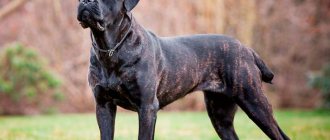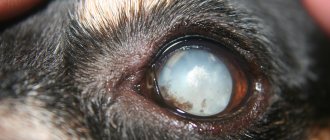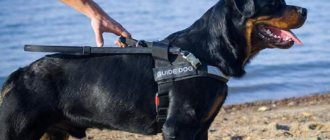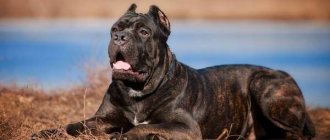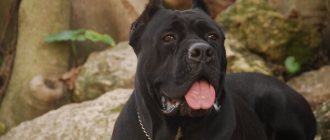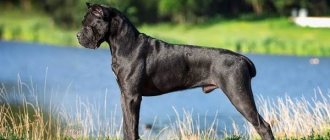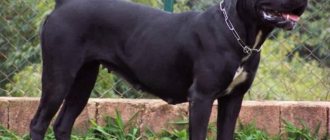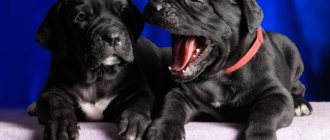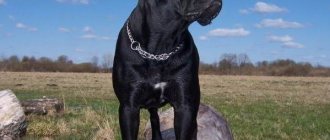The Cane Corso is an ancient breed whose ancestors were the Ancient Roman Molossian dogs. Even earlier, history mentions the ancestors of the Cane Corso among the Etruscan Great Danes, Persian and Carthaginian fighting dogs and Macedonian dogs. The modern breed combines the skills of guard and military service and gladiator combat.
Italian dog breeders are proud of the Can Corso breed, as they have made a significant contribution to the restoration of the breed and its lost uniqueness. The word "cane" is translated as "dog", and the Italians interpret "corso" as "guard", "yard" and "war horse". From the name it becomes clear that the Italians had a unique dog, capable of performing any service around the owner. She was entrusted with protecting the owner and his property, herding cattle, playing with small children, and she helped in bear hunting.
Characteristics of the Cane Corso
| Attachment level | High |
| Friendliness | Average |
| Suitable for children | No |
| Loyalty to other pets | Average |
| Exercise needs | High |
| Playfulness | Low |
| Energy level | Average |
| Learning ability | High |
| Intelligence | Average |
| Tendency to bark | Average |
| Shedding intensity | Average |
History of the Cane Corso
The Cane Corso originated in Italy and dates back to ancient times. The Molosser, a now extinct mastiff-type dog, is the ancestor of the Cane Corso and similar mastiff-type dogs.
Throughout its early history, the Cane Corso served as a guard dog, a fighting dog, and an accomplished hunter of a variety of game (including very large game).
Its name comes from the Italian word for "dog" and the Latin term cohors, meaning "protector" or "guardian".
A significant decline of the Cane Corso breed was caused by World Wars I and II, but a small number of dogs still existed. In the 1970s, Cane Corso enthusiasts revived the breed.
Cane Corso dog care
The Cane Corso has short, coarse hair. Body and coat care is very simple - just brush occasionally and bathe as needed.
Like other large dogs, the Cane Corso's nails can wear down naturally. However, sometimes nail trimming may be necessary. Check the length of your dog's nails regularly to ensure they remain comfortable for your dog.
The Cane Corso's ears are often trimmed into an equilateral triangle, but this is not a breed standard requirement.
It is advisable to crop the ears and tail before 4 months, after which the cartilage becomes stronger.
The tail is usually docked at the fourth vertebra.
- Burns
- Abscess
- Wounds
- Dislocations, sprains, bruises
- Fractures
- Canine distemper (distemper)
- Rabies
- Leishmaniasis
- Arachnoentomosis
9
The most common diseases of the Cane Corso
Every Cane Corso owner should be able to provide first aid to their pet in order to prevent its death or complications of the disease in cases where it is not immediately possible to contact a veterinarian or when a matter of minutes determines what the outcome of the disease will be for the animal.
It is very important to know the symptoms of major diseases and methods of treating them, but you should not try to make a diagnosis yourself. The owner’s suspicions may turn out to be incorrect due to the atypical course of a particular disease, and treatment will only bring harm. If you notice signs of one or another of the diseases described in this book in your dog, you must first contact a veterinarian. It is also necessary to call a doctor if your pet has a fever, refuses to eat, is apathetic or, conversely, shows excessive anxiety, etc.
Burns
High temperatures can cause 5 degree burns. With a first-degree burn, external manifestations include swelling, hyperemia, and in the case of the temperature effect of the flame, also charring of the dog’s coat. In stage II, caused by longer exposure, one or more blisters appear. Flame burns may not give such an effect due to charring of not only the fur, but also the epidermis, and instead of blisters, there will be severe swelling of the dermis and subcutaneous tissue. Blisters from a second degree burn usually burst, and the wound becomes infected without proper treatment, which leads to purulent dermatitis.
In case of a third degree burn, the papillary layer and subcutaneous tissue are involved in the process. IV degree burns are characterized by necrosis of the entire dermis and subcutaneous tissue. With extensive fourth-degree burns, independent healing is impossible. In order for epithelization to occur, small (1×1 cm) pieces of skin are transplanted. The most severe burn is V degree. It seizes a layer of muscles, causing their necrosis and leading to death.
Treatment for burns varies depending on the extent of the injury. In case of a low degree, immediately after the burn, you need to remove the fur from it and treat the affected area with solutions of potassium permanganate or silver nitrate, cooled to 2-4 °C. If you apply lotions in time, you can avoid the formation of bubbles. For more serious lesions, you should immediately call a veterinarian.
Abscess
Sometimes inflammation caused by pyogenic microorganisms leads to the formation of pathological hemispherical cavities. These are so-called abscesses. On palpation, the formations fluctuate, they are painful and cause high local temperature. The dog's overall body temperature also increases.
In the initial stages, the abscess is a hot-to-the-touch swelling of a pasty consistency with clearly defined edges. If left untreated, it enters the stage of cellular infiltration, characterized by thickening of the edema, increased body temperature, and the appearance of pain in the affected area. Interstitial pressure increases 3 times, loose tissue dies. The last stage of abscess formation is the abscess formation stage, in which the swelling takes on a hemispherical shape with areas of softening, the cellular barrier is replaced by a granulation barrier, which completely separates the affected tissues from healthy ones.
At the 1st stage of the disease, alcohol-drying bandages with a short novocaine-antibiotic blockade are applied for treatment, with the solution being applied to the site of inflammation. The benign course of the disease and timely assistance lead to the attenuation of inflammation and complete resorption of the abscess. At stage 2, the abscess cannot be treated; measures recommended at stage 1 only help to create a cellular barrier and isolate the necrotic area from healthy tissue.
A fully mature abscess is opened by making an incision directed downwards. The cavity of the opened abscess, after its contents have leaked out, is washed with hydrogen peroxide or a weak, no more than 1: 1000, solution of potassium permanganate. Strong antiseptic solutions are contraindicated at this stage, as they destroy the granulation barrier and can lead to infection spreading beyond the site of inflammation. In the absence of signs of necrosis of the granulation barrier, drainage with a 5-10% solution of calcium chloride with furatsilin in a ratio of 1: 5000 is introduced into the abscess cavity. Compresses are contraindicated in the treatment of stage 3 abscess.
Wounds
Treatment of wounds depends on their type and degree of damage.
The edges of the cut wounds are smooth and bleed heavily. Bitten, bruised and lacerated wounds bleed less profusely, but heal much worse than cut wounds. Puncture wounds are the least noticeable due to the dog's fur, do not cause large external bleeding, but can be very deep. The first thing to do when you discover a wound on your dog is to trim or shave the hair around the wound. Then the wound is washed with a solution of hydrogen peroxide and its edges are lubricated with iodine. If the wound does not exceed 2 cm in length and you are sure that it is shallow, it does not need to be sutured. Otherwise, the dog must be taken to the veterinarian. After the wound is cleaned and disinfected, it should be bandaged. You can use any clean cloth for bandaging.
When capillaries or veins are damaged, bleeding is usually minor and the blood is dark in color. In such cases, it is necessary to treat the wound and apply a tight pressure bandage. You can put an ice pack on top of the bandage so that the cold causes the blood vessels to constrict and reduce bleeding. The most dangerous is arterial bleeding, in which blood flows out in a pulsating stream of bright red color. In this case, a rubber tourniquet (or a twist from improvised means - a scarf, leash, etc.) should be applied above the wound, and the dog should be immediately transported to a veterinary clinic. Every 20-30 minutes, the tourniquet must be loosened for 1-2 minutes so that blood circulation is not impaired.
When wounds suppurate, first of all, it is necessary to remove pus and dead tissue with sterile swabs, and also to shave the hair around the damaged area of skin to a width of 3-5 cm. The affected area should be thoroughly washed with a 3% solution of hydrogen peroxide in half with a solution of furatsilin. The procedure must be repeated 2 times, after which the wound must be filled with tampons soaked in iodized alcohol in a ratio of 1: 1000. In case of serious damage, you must consult a doctor.
After providing assistance on the spot, you should definitely take your pet to a veterinary clinic, where an experienced specialist can perform the operation. It should also be noted that penetrating wounds to the chest and abdominal cavities must be treated within the first 2 hours, otherwise the dog may die.
Dislocations, sprains, bruises
If your pet is limping without external signs of damage to the limbs, it is necessary to check whether he has a dislocation, sprain or bruise of the joint. The main sign of a sprain is the dog's reluctance to step on the injured paw. In this case, the shape of the dislocated joint is changed, and the dog squeals due to sharp pain. If the owner has experience in treating such injuries, you can try to set the dislocated joint yourself. Otherwise, the dog must be given a painkiller and urgently taken to the nearest veterinary clinic. Sprains are more common in young dogs. With such damage, the dog practically does not step on the affected limb, the joint area is painful.
First aid consists of applying a tight bandage to the joint area; you can put an ice pack on top. To reduce pain, the dog is given painkillers. Sometimes lameness is a consequence of a bruise. In this case, there is a painful reaction to touching the bruised joint or bending the limb, but the joint is not deformed. To treat a bruise, apply a cold compress and give the dog an analgesic.
Fractures
One of the most difficult types of injuries are fractures. The main cause of fractures is mechanical damage to the limbs: bruises from a fall from a height and road accidents, sudden muscle contractions, forced release of a pinched limb, etc. There are also indirect causes that increase the possibility of a fracture: rickets, vitamin deficiency, osteomalaria, pregnancy (in case of calcium deficiency in the body).
Fractures are divided into open and closed, as well as fractures with and without displacement of bone fragments; in the second case, the fracture is usually closed. If the dog limps, experiences pain when palpating the injured limb, the bone outside the joint on the paw is mobile and deformed, but there is no open wound, a closed fracture can be diagnosed.
An open fracture is characterized by a wound that causes deformation of the damaged area of the bone. Its fragments stick out from the wound. To help a dog with a closed fracture without displacing bone fragments, a fixing splint should be applied to the limb and the animal should be given an analgesic. The fixing plaster cast, like the temporary splint, should cover the fracture zone and the 2 nearest joints. In this regard, it is impossible to plaster fractures of the femur and humerus. Other methods are used to fix them. The plaster is removed at 45 days, and in young dogs - at 30 days.
An open fracture without displacement can also be treated using a plaster cast, but a window should be left over the wound for treatment. In addition, cases of such fractures in animals are extremely rare. Mostly open fractures in dogs occur with displacement of bone fragments and require surgical treatment.
First aid for an open fracture is to stop bleeding, compensate for blood loss, and eliminate shock. The limb is secured with a temporary splint and the dog is taken to a veterinary clinic.
Canine distemper (distemper)
An acute contagious disease caused by a virus, known as canine distemper, commonly known as distemper, often affects unvaccinated young dogs.
Infection can occur 2 weeks after the end of the suckling period. Cases of the disease in earlier childhood were observed only when puppies were fed by a sick mother, as well as insufficient animal hygiene and the presence of a highly virulent infection.
After illness, animals remain virus carriers for about 2-3 months, that is, they can infect surrounding dogs without getting sick themselves. Dogs are also contagious during the incubation period, when the infection has not yet manifested itself, but infection has already occurred. Typically, this period in Cane Corso lasts from 2 to 3 weeks, although with a weakly virulent strain of the virus and good housing conditions it can last up to a month.
Infection with plague occurs not only from other animals, but also through care items, bedding belonging to sick dogs, and their feces. The virus can also be carried by birds, rodents, blood-sucking insects, and people who do not follow the rules of hygiene when interacting with a sick animal. The virus enters the Cane Corso's respiratory tract, as well as the gastrointestinal tract, which causes infection.
Classification of forms of canine distemper is carried out according to the nature of the course and the external manifestation of clinical signs. There are acute, subacute, chronic, fulminant, abortive, typical and atypical course of the disease, as well as its manifestation in the form of catarrhal, intestinal, pulmonary and nervous forms. In practice, there are no pure forms of the disease; plague occurs in a mixed form.
Usually, in the first days of illness, the Cane Corso’s temperature rises and a fever begins. If these symptoms are combined with the appearance of a small red rash on hairless areas of the skin, which after 2 days turns into nodules and blisters with yellowish-green contents, then there is a high probability that the pet is suffering from plague.
After a few days, sick Cane Corso refuse to feed, signs of photophobia appear, the nose becomes covered with dry crusts, and sometimes vomiting is observed. Another external sign of plague can be considered conjunctivitis that develops on the 2-3rd day after the temperature rises. A serous and then purulent secretion constantly oozes from the dog’s nostrils, the nostrils stick together, which leads to difficulty breathing. During this period, dogs develop catarrh of the intestines.
The stool changes; in the liquid stool, yellow or gray-yellow, and then brown with an unpleasant odor, you can notice streaks or blood clots, mucus and undigested pieces of food. Due to constant diarrhea, the dog may develop dehydration and rectal prolapse.
The duration of the disease depends on its form. With fulminant plague, dogs die in one day without showing clinical signs; the hyperacute course is characterized by a 2-3-day course, ending in coma and death. Fortunately, both of these forms of plague are quite rare; acute and chronic forms of the disease are most common. In the first case, the disease lasts from 2 weeks to 1 month, in the second it can last up to six months.
With chronic distemper, periods of exacerbation alternate with periods of remission, the coat looks disheveled, and there are crusts in the corners of the eyes and on the nose. With this course of the disease, the animal faces various complications, which often cause the death of the dog.
In the absence of treatment, as well as in the acute form of canine distemper, damage to the nervous system develops towards the end of the disease, expressed in short-term agitation, convulsive muscle contractions, paralysis of the hind limbs, epileptic seizures and profuse salivation. Damage to the nervous system indicates an extremely unfavorable prognosis. About 90% of dogs in which they are observed die.
Treatment is carried out with drugs of various groups. They must be prescribed by a veterinarian. At the onset of the disease, calcium gluconate is administered 1-5 ml daily for a week, while injections of 6% vitamin B12 5 ml are recommended. 40% methenamine, 1% diphenhydramine, 1.5% ascorbic acid, etc. are indicated. To prevent infection of other dogs, the infected animal is isolated, and all care items and the room in which it was located are treated with 2% formaldehyde solution or sodium hydroxide.
Rabies
Rabies belongs to a group of diseases that are especially dangerous for both dogs and humans. It is viral in nature and affects dogs, cats, foxes, etc. Rabies in Cane Corso has several forms, of which the most common are abortive, violent and paralytic (silent). Regardless of the form of the disease, the incubation period ranges from 14 days to 3 months, and infection occurs only in 1/3 of bitten people and animals (the disease is transmitted through saliva during a bite, and clothing and wool can become a barrier to its entry into the body, except In addition, the immunological state of the bitten person is important). The most dangerous are considered to be bites from a rabid animal to the head and areas of nerve nodes. In this case, the pathogen attacks the nervous tissue much faster.
The most common form of the disease among dogs is the violent form of the disease. When rabies occurs in this way, the Cane Corso dies in 6-11 days. At the nervous stage, the animal shows apathy, hides from people in a dark place and stubbornly does not respond to the owner’s call. If these symptoms occur in combination with recent bites from other animals, you should contact your veterinarian immediately. Some Cane Corsos become hypersocial instead of fearful. The dog clings to the owner and strangers, tries to lick their hands and face, which is extremely dangerous due to the presence of a virus in the saliva. Later, in both cases, aggressiveness sharply manifests itself. The pet lies down and jumps up for no reason, makes movements like when catching flies, it develops shortness of breath and itching at the site of the bite, the pupils dilate, viscous saliva begins to flow abundantly from the mouth. Appetite worsens, swallowing is difficult due to paralysis of the lower jaw, and vomiting is noted.
The second stage of the disease is characterized by even greater agitation and aggressiveness. The pet begins to rush at all the people and animals it sees, even bites objects and the ground, it develops increased endurance, there are cases when escaped dogs in the second stage of rabies ran up to 50 km per day and returned home. The affected animal's bites become so severe that it can break its teeth or jaw. The dog is drooling with a slack jaw, aggressive, head and tail drooping.
The dog bites without warning, without showing preliminary signs of aggression in the form of barking or growling. The barking itself becomes hoarse, more reminiscent of a howl. Paralysis of the hind limbs and pharynx progresses. The animal tries to swallow food and water, but cannot do so. It was because of this feature that in the Middle Ages rabies was called hydrophobia.
Periods of violence in the second stage alternate with peace, and then disappear altogether. The dog becomes indifferent, its hind limbs, throat and lower jaw are completely paralyzed. Usually this stage lasts no more than 5 days and ends with the death of the dog in a comatose state. In the last days of life, rabid Cane Corsos not only have paralyzed limbs and lower jaw, but also some internal organs stop functioning.
In paralytic rabies, the violent form is absent. The Cane Corso does not show aggression, behaves calmly, and retains its appetite. Characteristic signs may include paralysis of the lower jaw and pharynx, creating the feeling that the animal is choking on a bone. Typically, attempts to remove this non-existent bone lead to human infection. The abortive form of rabies manifests itself after vaccinations against this disease; it is extremely rare in nature and has not been sufficiently studied. The main characteristic of this form of the disease in dogs is that after the classically occurring first stage, the disease suddenly fades and goes away completely.
The disease cannot be treated; dogs die on the 6-11th day in the violent form and on the 2-4th day in the paralytic form. Cane Corsos diagnosed with rabies must be immediately euthanized.
Dogs suspected of having rabies or bitten by stray or wild animals that may be suspected of having rabies, as well as Cane Corsos that bite people while walking, are isolated and quarantined for up to 10 days, during which investigations are carried out. If an infection is detected, the dog is euthanized, and the enclosure where it was kept is disinfected. If the animal turns out to be healthy, it is returned to its owner after quarantine.
Leishmaniasis
Leishmaniasis is a disease that affects both humans and animals. The Cane Corso has two forms: internal and external. The causative agent of the disease is Leishmania - microorganisms belonging to protozoa. These parasites are oval in shape and go through two stages in their development: flagellated and non-flagellated. Infection of dogs occurs mainly through the bites of blood-sucking insects (horse flies, mosquitoes). Most often observed in Cane Corso up to 2 years of age. Animals that have recovered from the disease develop a fairly strong immunity.
A
b
Causative agents of leishmaniasis: a – flagellated form; b – flagellated form
The disease occurs both acutely and chronically, its cutaneous form is manifested by ulcerations on the back of the nose, lips and eyebrows. Body temperature remains virtually unchanged. The lymph nodes are slightly enlarged; with a long course of the disease, they become lumpy, thicken, but remain mobile, unlike tumors. The lymph nodes of a sick dog contain many pathogens of leishmaniasis. Over time, nodules form on the affected areas.
Internal leishmaniasis differs from external leishmaniasis in symptoms: the presence of fever, anemia, exhaustion and diarrhea. The dog's head and back become bald, conjunctivitis may occur, and the nasal mucosa may ulcerate. The prognosis is unfavorable; most often, a few weeks after the first signs of the disease appear, the dog dies. An autopsy shows an enlargement of the liver and spleen by at least 2 times, the bone marrow is susceptible to hyperplasia and is colored red. Treatment for the internal form of the disease has not been developed, but the external form is treated by injecting primary nodules and secondary lesions with a 5% solution of quinine. Prevention involves the destruction of patients with the internal form of leishmaniasis in dogs and the extermination of disease carriers.
¦ NEMATODOSIS
The general name for diseases caused by helminths (nematodes) parasitizing the intestines. The most common of all nematodes in the Cane Corso's intestines are Toxocara. Dogs of all ages are susceptible to it, but these parasites are most often found in puppies. When examining the stool of sick dogs, small spindle-shaped worms of light yellow color are found.
Classic manifestations of cutaneous leishmaniasis
The development cycle is the same as that of roundworms; helminth eggs are released with feces into the environment, where they reach the invasive stage. After infection through contaminated food or water, nematode larvae penetrate the intestinal cells, are carried by the bloodstream throughout the body (primarily to the lungs), from where, penetrating into the tissues, they enter the oral cavity and are transported a second time into the intestines, where their final maturation occurs.
Sick animals lose weight, their gastrointestinal tract is disrupted, and their appetite disappears. Often there is bloating of the abdomen, which gives the impression of rickets, and the dog eating its own feces.
For treatment, decaris and thividine are mainly used, although deworming can also be carried out by other means. The drugs are given after a 12-hour fast in a mixture with minced meat. The administration dose is usually 0.002-0.003 g per 1 kg of dog body weight. 1 hour after feeding with decaris, it is recommended to give the puppy a laxative.
To prevent infection with nematodes, it is necessary to follow zoohygienic rules and teach the puppy not to pick up the feces of other animals. In addition, contamination of feed with soil and manure is unacceptable. To prevent re-infection, the feces of sick dogs are destroyed (burned) until the 6th day after deworming.
In order to prevent nematodes and other helminthic diseases, all puppies at the age of 25 days are subjected to deworming.
Arachnoentomosis
A group of diseases caused by external parasites that feed on the blood, fluff and hair of animals, as well as skin flakes, are called arachnoenthomoses. The most well-known parasites that cause such lesions are fleas and scabies mites. In addition to dogs, ticks and fleas infect cats, rodents, wild mammals and humans.
¦ CAUSES OF SCABIES
Scabies mites have a fused head, chest and abdomen, as a result of which their shape is tortoiseshell-shaped; the color of the parasite is usually dirty white, in heavily chitinized areas it is light brown. The oral apparatus consists of a proboscis located on the front of the body, two pairs of scissor-shaped upper jaws and lower ones, fused into a round plate covered with a layer of chitin. Ticks have four pairs of jointed legs ending in suckers, except for the third pair in males, and in females also the fourth. These pairs of legs end in long setae. The body of the parasite is covered with rows of spines and bristles of various shapes. The size of female jellies does not exceed 0.5 mm, while males are usually much smaller. The eggs of parasites are oval in shape, the shell is transparent, and the length does not exceed 0.15 mm.
Itching mites live in the thickness of the epithelial tissue, gnaw passages in it and thereby cause scabies. The average lifespan of a female is 50 days; males die almost immediately after entering the adult stage, having only time to perform fertilization. After fertilization, the female bites into the skin, lays eggs in it, and then also gnaws through the aerating passages. Each tick lays at least 30 eggs, from which larvae hatch after 3-6 days. After another 3 days, the larva molts and turns into a nymph.
Several molts with the transition of the larva from one stage of development to another takes an average of 10 days, then the transformation into an adult male or female occurs.
By irritating the skin with waste products and mechanically injuring it when gnawing passages, mites cause severe itching and the formation of pustules and vesicles. The dog's skin becomes inflamed, the exudate that is released from the foci of inflammation dries out and forms crusts, the hair loses its shine, seems tousled, and in places where there is abundant exudate it sticks together, forming crusts. There is also general intoxication of the body caused by excrement released by parasites entering the bloodstream. The first symptoms are usually noticeable already on the 15th day after infection with ticks. When a Cane Corso is parasitized by mites of the genus Sarcoptes, the foci of scabies are localized during this period on the head, end of the tail and lower part of the chest, but if the animal is infected with mites of the genus Notoedres - on the head. That is why it should be alarming if a dog scratches these areas of skin until they bleed. It is also necessary to begin an examination with them if scabies is suspected.
A
b
1
A
b
Itching mites: 1 – genus Sarcoptes; 2 – genus Notoedres; a – male, ventral surface; b – female, dorsal surface
When diagnosing scabies, scrapings are made to the ichor from the border of the affected areas in at least 3 places. Based on the results of their research, tick-borne parasitic infection is differentiated from eczema, microscopy and leishmaniasis. A definitive diagnosis can be considered only after detection of mites or their eggs in samples.
Treatment of this disease is long and complex. Hexalin, colloidal sulfur and activated creolin are usually prescribed. The bath temperature when bathing a dog should be 30-32 °C, the duration of the procedure should be at least 2 minutes.
During treatment, it is better to grab the animal’s jaws with a ribbon to prevent bites. It is necessary to ensure that the dog's skin is well moistened with the medicinal product. To do this, run the hand against the fur several times along the dog’s limbs and body. Towards the end of bathing, close the dog’s nostrils and mouth with your hand and plunge it into the water with its head 1-2 times. Dogs with suspected scabies are washed using the same scheme twice a week. The total number of bathing in this case may not exceed 3 times.
During the cold season, bathing and keeping sick animals is permissible only in well-ventilated, warm rooms, where they should remain until completely dry. If there is no opportunity to bathe a dog infected with a tick, it is treated with sulfur dust, as well as kosan or thiovit. The content of the active substance in the drug must be at least 80%. After such treatment, scratching the affected areas of the skin and licking them should not be allowed. For this purpose, it is best to put a wide cardboard collar on the dog.
To prevent infection, it is necessary to treat all care items for a sick dog with a 2% chlorophos solution or a hot 3% aqueous creolin emulsion. The premises are treated with the same means. To prevent scabies infection, you should not have contact with stray animals.
¦ EAR MITE
This parasite lives on the inner surface of the skin of the auricle and belongs to the carpet beetle mites. Most often, infection occurs from wild animals and cats. Humans are immune to ear mites. Externally, skin beetles are similar to scabies mites, differing only in location and size (females are no larger than 0.75 mm, and males - 0.6 mm). The full development cycle of the parasite, depending on external conditions, ranges from 18 to 25 days and proceeds in almost the same way as in pruritus.
Mechanical trauma to the skin and waste products of ear mites cause severe irritation and itching. The Cane Corso scratches the ear, the inner surface of which at the beginning of the disease remains clean, but becomes hyperemic and slightly swollen. Later, exudate begins to sweat, which mixes with flakes of dead skin and secretions of the sebaceous glands and the mites themselves. A specific viscous brown lubricant is formed, which, when dried, forms scabs that clog the ear canal and increase irritation and itching.
In later stages, a purulent mass flows from the ear, gluing the fur in front of the auricle, the animal tilts its head, turning the sore ear down. The transition of inflammation to the meninges leads to seizures and death of the dog, but this rarely happens: most often, owners notice an ear mite infection in time based on the classic symptoms (itching in the dog’s ear and a brown mass in the ear canal) and begin treatment.
Male ear mite (dorsal surface)
Treatment of this disease is carried out with hexalin, hexatalp, nicochloran (all three drugs in 0.03% concentration), 5% gardon, 40% phenothiazine or acrodex. The preparations are diluted with non-irritating animal or vegetable fats. Before treatment, the ear is cleaned of exudate with a cotton-gauze swab or napkin, and the composition is heated to 30 °C.
Typically, 1-2 ml of the composition is used for one treatment. To ensure its even distribution throughout the auricle, the Cane Corso's ear is folded in half and massaged at the base. Treatment should be carried out for at least 12 days, 2-3 times a day. The result is the creation of unfavorable conditions for the development of ear mites for 24 days, as a result of which the parasites have time to die both on the animal’s body and in the external environment; re-infection does not occur and sanitization of the premises is not required.
If there are several animals in one room, then all of them must be treated for ear mite infestation, and those that are apparently healthy and kept together with sick animals must undergo several preventive treatments according to the regimen prescribed by the veterinarian. Also, for the purpose of prevention, the Cane Corso is not allowed to interact with stray animals and domestic cats with signs of infection with ear mites.
¦ DOG, CAT AND HUMAN FLEAS
All three types of fleas listed above parasitize the Cane Corso and cause severe itching, dermatitis and anemia, and in addition, they can serve as carriers of some infectious diseases.
An adult flea is a laterally compressed parasite, 0.5 to 3 mm long, dark brown or black in color, with a piercing-sucking mouthpart. The chest consists of three segments, each of which has a pair of jointed limbs. The hind pair of legs serves the insect for jumping and is elongated compared to the others. The abdomen is also segmented.
Due to the speed of their movement, it is quite difficult to notice fleas until they breed in the dog’s fur. Much more often, in the early stages of infestation, owners discover motionless small white eggs dotting the dog’s undercoat near the tail, or black grains of discharge on the skin.
The development cycle of a flea is as follows: from the eggs laid by the female on the 8-14th day, larvae hatch, feeding on the feces of adult insects; Moulting three times during the growth process, the future flea finally entangles itself in a cocoon of cobwebs and turns into a motionless pupa that does not require food. After 12 days, the pupa turns into an adult insect. The lifespan of an adult flea can range from several months to 1 year.
When a flea bites, saliva is released into the wound, causing skin irritation. The Cane Corso begins to scratch the itchy areas of the skin, which leads to additional injury and complications of micro-wounds with purulent and other infections. The animal becomes disobedient, inattentive, and restless. Puppies, in addition, suffer from anemia and exhaustion.
A
b
V
G
Stages of flea development: a – egg; b – larva; c – pupa; d – adult insect
Fleas easily jump from one animal to another and even to humans; in addition, infection can occur through the bedding of a Cane Corso. As a preventative measure, it is recommended to carry out examinations of the animal, paying attention to the neck and abdomen, and also to prevent the dog from coming into contact with stray and wild animals. If parasites are detected on your pet, you should treat it with 2% chlorophos dust. During processing, the Cane Corso is placed in a special bag with a tie that is secured to the top of the neck. The duration of the procedure should be at least 10 minutes.
In case of severe damage, it is recommended to wash the animal in a bath with a hexachloroancreoline preparation at a concentration of 0.015%. The treatment is carried out twice, the period between bathing and dust treatment in the summer is from 10 to 12 days, and in the winter – 14-18 days. In addition to the above measures, it makes sense to use a specialized pet shampoo against parasites as a preventive measure and in case of mild infestation. The Cane Corso's bedding should also be treated with a 1% aqueous solution of chlorophos at the same time as treating the dog.
¦ VLASOYE
Ubiquitous, these parasites, in addition to dogs, can infect cats, wild predatory animals and rodents. This is a pale yellow insect, up to 2 mm long, that lives in animal fur.
61 The body of the lice eater is highly chitinized and flattened, the head is quadrangular in shape and larger than the chest. The oral apparatus is designed for chewing skin flakes. Lice eaters also feed on young hair.
The parasite has three pairs of legs with claws, its segmented abdomen is longer than the size of its head and chest and, unlike them, is covered with bristles. Lice eaters develop from eggs up to 0.4 mm in size, from which larvae emerge, and 2-3 weeks after molting, an adult insect emerges. The eggs of these parasites, unlike flea eggs, are glued to the fur by a sticky substance secreted by the female.
Healthy animals become infected through contact with sick animals, as well as through care items. Lice eaters cause severe itching in the Cane Corso, leading to scratching and, as a result, infection of the wounds. In addition, the coat thins. Most often, parasites are localized at the root of the tail, on the head and the inner surface of the paws. In adult dogs, their number is small, but lesions on a puppy’s body can even affect the sides and back.
Treatment comes down to treating the dog and the room in which it is kept with intavir, stomozan or cypermethrin in concentrations of 0.08, 0.02 and 0.01%, respectively. The animal is bathed in the indicated solutions, heated to 20 ° C (higher temperatures may weaken the effect of the drug).
Adult lice eater
The duration of bathing is 2 minutes, and the frequency of treatments is once every 14 days. Usually 2-3 baths are enough. In addition to the listed drugs, zoo shampoo is successfully used against lice eaters, as well as against fleas. Prevention is identical to preventing flea infestation.
Table of contents
Training and exercises
The Cane Corso is a true working breed, active and purposeful. Daily exercise will help keep your Cane Corso in physical and psychological condition.
A brisk walk or jog of at least a kilometer is a good start. If you don't have a job for your Cane Corso, he may find his own and end up digging holes and chewing your things.
If you have a farm, the dog can herd livestock. But if you're a more typical homeowner, spend time every day exercising your dogs, learning tricks, or practicing obedience skills.
It is better for a Cane Corso to be adopted by someone who is familiar with dog training rather than a novice. Proper training and socialization are important for all Cane Corsos.
With a natural aversion to strangers and a tendency to be territorial, you must be diligent and consistent during your training.
This is also important due to the dog's gigantic size; Particular attention should be paid to preventing jumping, bending and pulling on the leash. Cane Corsos are smart and hard-working, so training this breed is not difficult.
Despite its appearance, which may seem intimidating to some, the Cane Corso can actually be affectionate and gentle. This breed will bond closely with its family and act as a protector.
With proper handling and socialization, the Cane Corso can get along well with children, even forming close relationships. However, children also need to be taught how to behave around dogs and never leave them unattended.
The Cane Corso needs a strong and high fence when he is taken outside.
This breed has a high prey drive and is prone to chasing and killing small animals such as cats and other dogs.
They are territorial and will patrol the fence line, protecting property from passersby.
Upbringing
The Cane Corso needs training and a strong hand from puppyhood. Socialization from an early age is also desirable, otherwise the Corso may show aggression towards dogs.
A Corso puppy requires a lot of investment. This is high-quality food and mineral and vitamin supplements, toys and ammunition.
To raise a balanced, obedient dog, you need regular classes with a dog handler who knows the characteristics of the breed. An uncontrolled, disobedient adult dog can become dangerous to its owner and the people around him.
Keeping such an animal is a big responsibility.
Diseases of the breed
The breed may experience some hereditary health problems. Please be aware of the following conditions:
- Hip dysplasia: This is an inherited condition that can lead to lameness and arthritis.
- Gastric dilatation - gastric volvulus: You may experience bloating after eating and drinking too quickly. If your stomach twists, it can cut off your blood supply and cause a medical emergency.
- Ectropion: A common condition in which the lower eyelids droop or untwist.
More dog breeds
If you think a Cane Corso might be a good fit for you, try to find Cane Corso breeders and owners in your area so you can spend some time with the breed first.
Also, consider looking for volunteers for Cane Corso adoptions. Make sure you understand what is needed to properly care for this breed before introducing it into your life.
If you're interested in similar breeds, take a look at these to compare the pros and cons:
Mastiff
Bullmastiff
Dogue de Bordeaux
Also interesting:
Italian names for dogs for boys and girls
Nutrition
Cane Corsos are very active animals, so it is important to provide their body with enough food to replenish their strength and energy. The diet can be represented by dry industrial food or natural food. In the latter option, four-legged pets need to be fed:
- milk (puppies);
- fermented milk products (yogurt, kefir, cheese, cottage cheese);
- sea fish without bones;
- eggs;
- meat (chicken, turkey, rabbit, beef);
- beef bones;
- vegetables (carrots, cabbage);
- berries (raspberries, cherries and pitted apricots);
- fruits (apples);
- butter;
- porridge;
- vitamin and mineral complexes.
It is prohibited to include in the diet:
- pork;
- bird bones;
- pickled dishes;
- boiled bones;
- salo;
- seasonings;
- sweet and salty foods;
- fat;
- mayonnaise;
- vinegar;
- ketchup;
- mustard.
If the choice falls on industrial food, you will need to select it taking into account the breed and needs of the dog. On average, an adult should eat about 800 grams of dry food daily.

